I grew up with St Anthony, the saint who, for a fee, can find just about anything you’ve lost. And you don’t have to be a believer. He came from some exotic place called Padua, which to the imaginings of a 10-year-old child in Ireland was as far away as Timbuktu. It took a while but I finally made it to Padova, what the Italians call the city I know as Padua, some 38 km (23 miles) west of Venice..
If the city is marked by its railway tracks, we stayed outside, on the far side, in a neighbourhood called Arcella. Our walk to the station and into town was a colourful one; the ‘hood is very ethnic. It’s where many non-Italians have put down roots. There are people on the streets (mainly young men) hanging about, chatting, weighing the world up. There’s a gauntlet of Asian restaurants to pass through before you hit the river, where the inner Padua begins. Funnily, the best prosecco I had this trip was in a Chinese restaurant that goes by the name of Tian Yi JiAO Padova Angolo del Mondo. It was so good (the food and the prosecco), we went back twice.

The city, home to Italy’s second oldest university (something that completely escaped me). I was there for the churches and the frescoes. I was there to see St Anthony. He’s everywhere. I got mass in the Sanctury of Arcella not knowing that it was in a room in this church that St Anthony died on 13 June 1231.
We made a beeline for the Cathedral (the Duomo) and found instead that it was dedicated to St Mary of the Assumption. St Anthony was in the Basilica. No regrets though at not having done my homework as I’d have missed this gem of a church. The first church here was destroyed during the Hungarian invasion of 899. It was rebuilt, the first of five rebuilds, one of which ran from 1547 to 1754. I found a description of the church: huge and dull. Huge yes. Dull? No. Granted, there’s little by way of explanation of anything so it’s a guessing game as to who’s who and what’s what. With one exception: the tomb of Gregorio Giovanni Gaspare Barbarigo.

I hadn’t a clue who he was, then. I know now though. He seems to have been one of the good guys, visiting all the parishes in his diocese and giving away his stuff to the poor. Walking the talk. I was taken by the altar and the modern pulpit with the moving cloth of Jesus on the crucifix. The curious mix of old and new gave me pause for thought. I’m still not sure. But if its aim was to keep me there longer, it worked.

The crypt deserves a post of its own over on Dying to get in. But here’s a taster. The frescoes here are nothing on what’s next door in the bapistry. Oh had I known. But I didn’t. Another reason to come back.

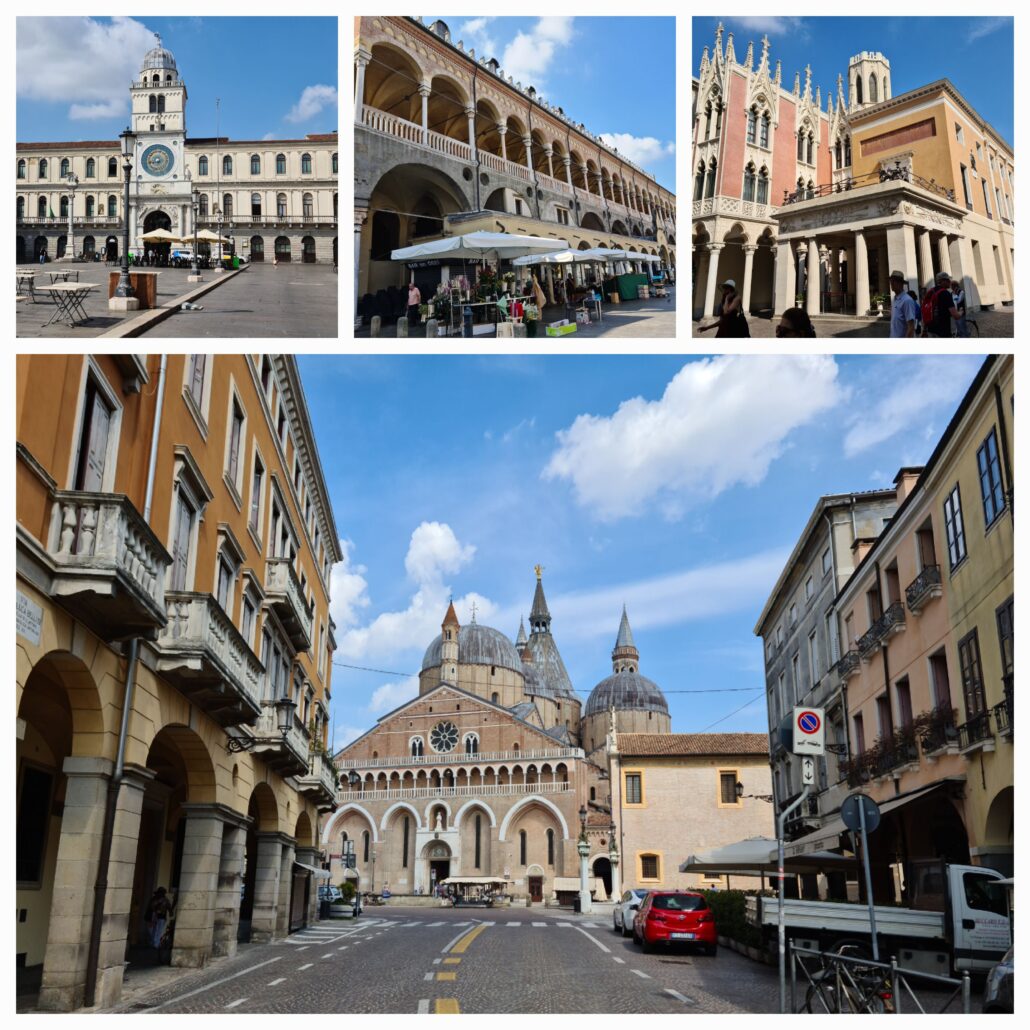
After wandering the streets and enjoying the city for what it is – a lively university town with some stunning architecture, nice green space, and plenty on offer by way of food and drink – we found the Basilica, the resting place of St Anthony and a respository of his bits and pieces: his tongue, his jawbone, his vocal chords, and more. These are all what we Catholics call first class relics.
Relics are divided into three classifications. A first class relic is a body part of a saint, such as bone, blood, or flesh. Second class relics are possessions that a saint owned, and third class relics are objects that have been touched to a first or second class relic or the saint has touched him or herself.
I had a fleeting thought of what a Martian might think – all these body parts and a chap hanging on from a cross over the altar. Hardly conducive to thinking fondly of the religion. The church is stunning. The frescoes amazing in their colour. The overall effect is gobsmacking.
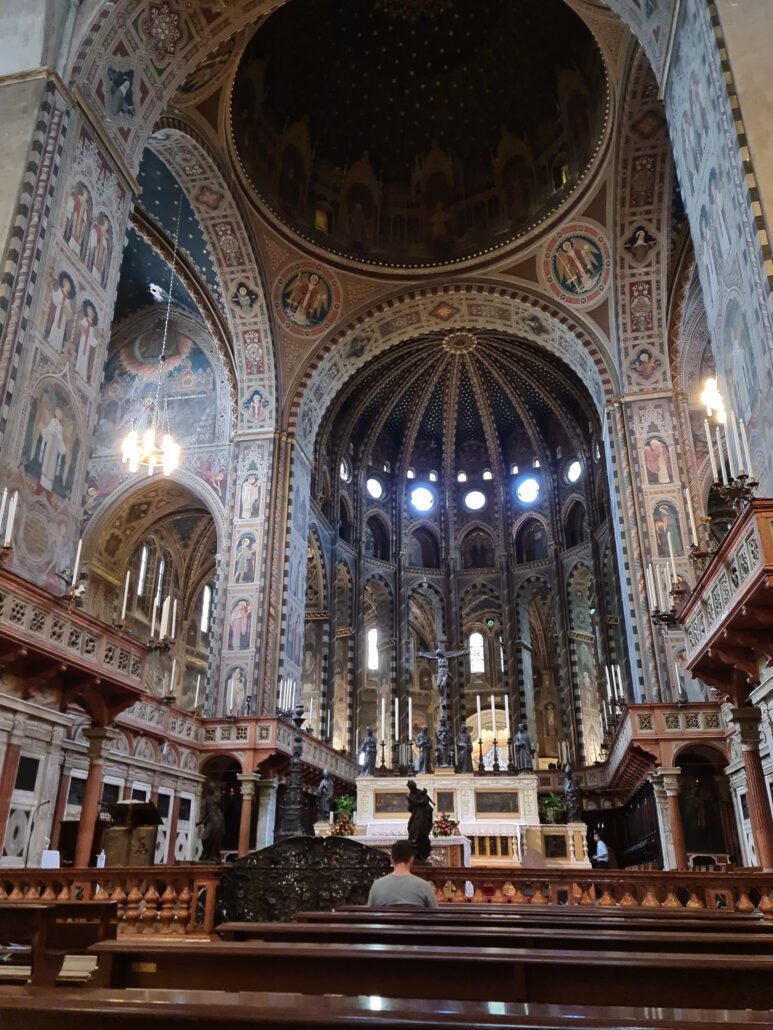


I was particularily taken by a fresco in one of the niches depicting the miracle at Rimini.
Once Anthony had travelled to the city of Rimini because it was a hotbed of heresy. The city leaders had ordered everyone to ignore him, so no one turned up for his homilies. Wherever Anthony went, he was greeted by silence. Anthony walked along praying and reflecting upon what had happened. As he walked outside of the town, he came to the mouth of the Marecchia River where it flows into the Adriatic. There he began to address the crowds, not of people but of fish. He called out, “You, fish of the river and sea, listen to the Word of God because the heretics do not wish to hear it.” Suddenly there were thousands of fish neatly arranged in rows, all pushing their heads through the surface of the water as if they were straining to listen to every one of Anthony’s words. The people of Rimini, seeing this miracle, gathered to listen to Anthony. What began with simple interest in an extraordinary event turned into a passionate conviction that Anthony was speaking to their very hearts. They were so moved by Anthony’s words, by his call to conversion, that they abandoned their hardened positions and returned to the Church.

Everywhere there was something to see. I was mega impressed, even more so knowing that those who’d come before me rated the Scrovegni Chapel even higher than the thirteenth-century Basilica of St Anthony.
The chapel is relatively innocuous as chapels go in Italy. It’s been around since the late thirteenth century and was bought in 1300 by a banker called Enrico Scrovegni. He didn’t buy the chapel per se; it came with the vast expanse of land he bought from the Dalesmanini family who had fallen on hard times. He built himself a palace and rebuilt the chapel as a family oratory. Some say he built it to atone for this father’s sin of usury – he was one of the usurers mentioned in Dante’s Inferno. The link might be a little less suspicious though as Dante and Giotto were friends and Giotto was the chap hired to paint the interior of the chapel.
Giotto is most remembered for his break with the traditional Byzantine style, and by introducing the technique of drawing accurately from life. He went away with the typical Byzantine style of elongated faces and stylized clothing, and instead incorporated three-dimensional forms, based on real observation, and garments hanging naturally with real weight. All of his breaks from tradition earned him the reputation of creating a new standard of representational painting. He actively invited the viewer into the scene by creating real human faces and real emotion.
The depictions include the story of Christ and a particularly vivid depiction of hell.
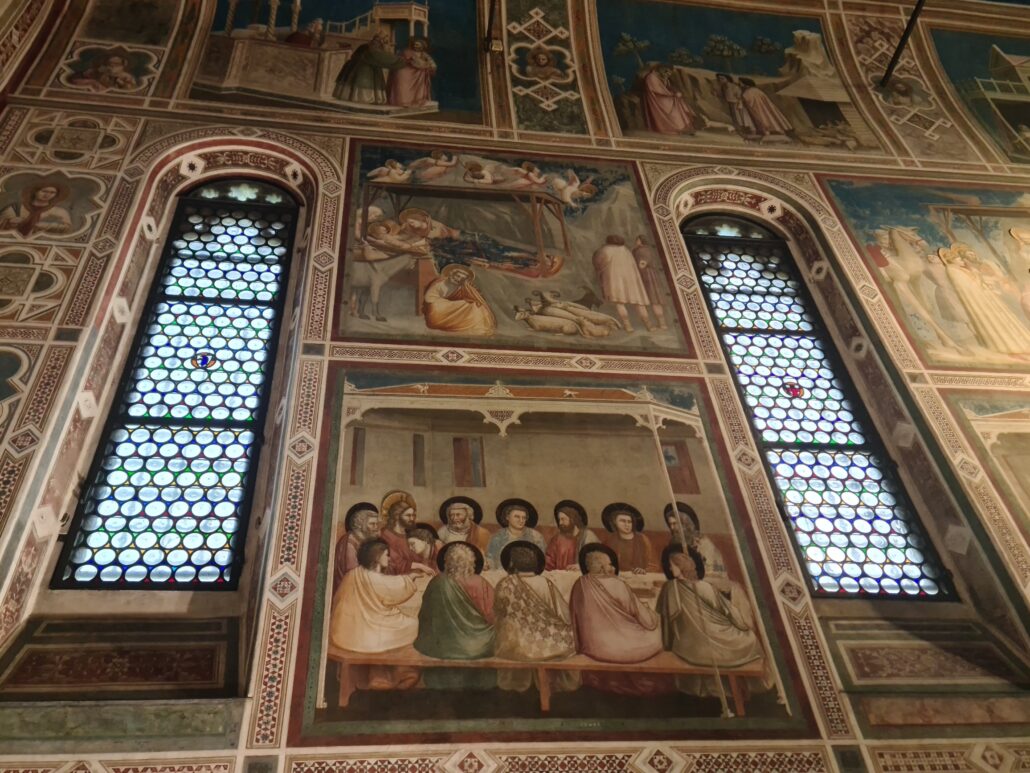
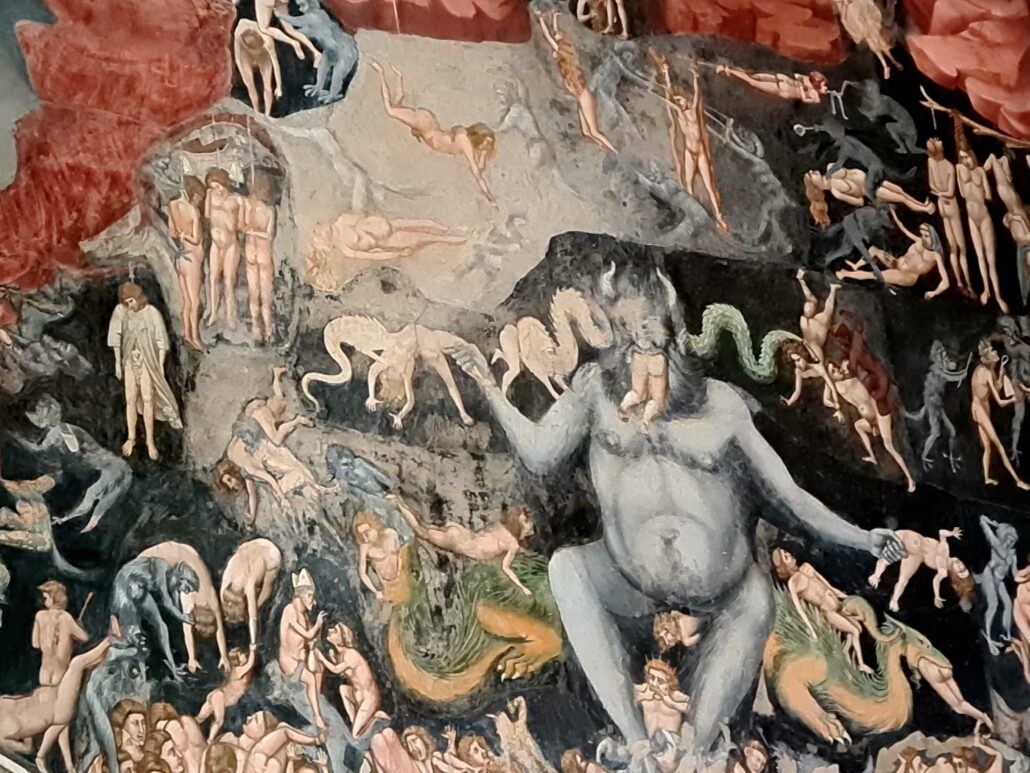
The short movie you see before going inside explains what to expect and makes it all the easier to take it all in. You don’t get much time – maybe 15 minutes at most – which isn’t enough to do it justice. Without the movie, I’d have been lost.
The founder is shown offering a model of the church in the huge Last Judgment, which covers the whole west wall. The rest of the small, bare church is covered with frescoes in three tiers representing scenes from the lives of Saints Joachim and Anne, the life of the Virgin, the Annunciation (on the chancel arch), and the life and Passion of Christ, concluding with Pentecost. Below these three narrative bands is a fourth containing monochrome personifications of the Virtues and Vices.
I wanted to see the kiss – the first kiss ever painted. St Joachim and St Anne – Mary’s parents – kissing at the gates of Jerusalem.
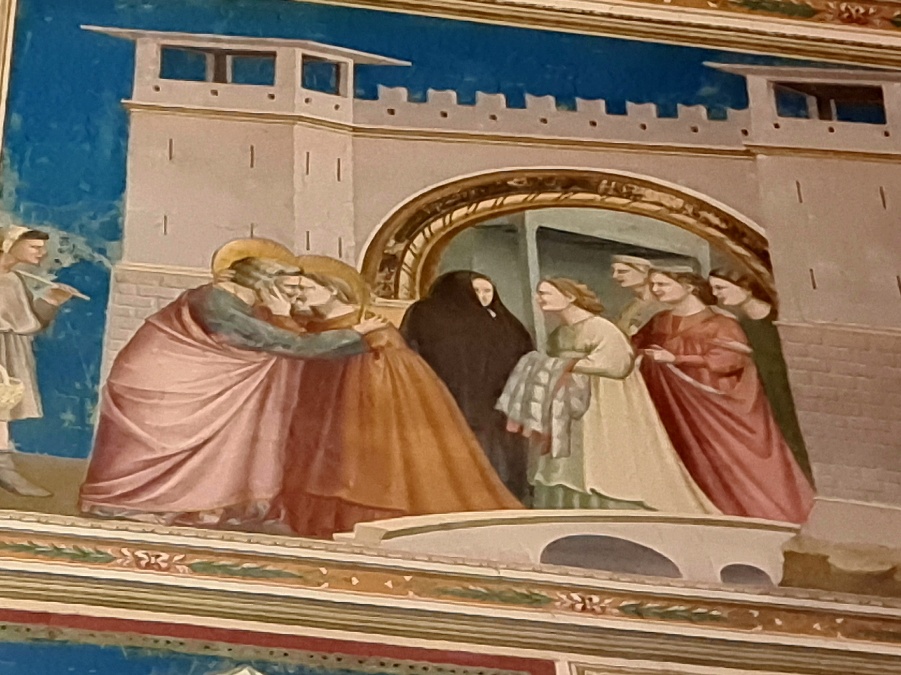
It’s spectacular. But better than the Basilica? I’m not convinced.
There’s more that Giotto at play when it comes to art in Padua. I was taken by the street art of Kenny Random (Andrea Copp) who seems fixated with a man in a hat with his cat. Word has it that when building are being renovated, his art is protected. And, back in 2011, Roman Abramovich bought one of his pieces. They certainly brought a smile to my face.
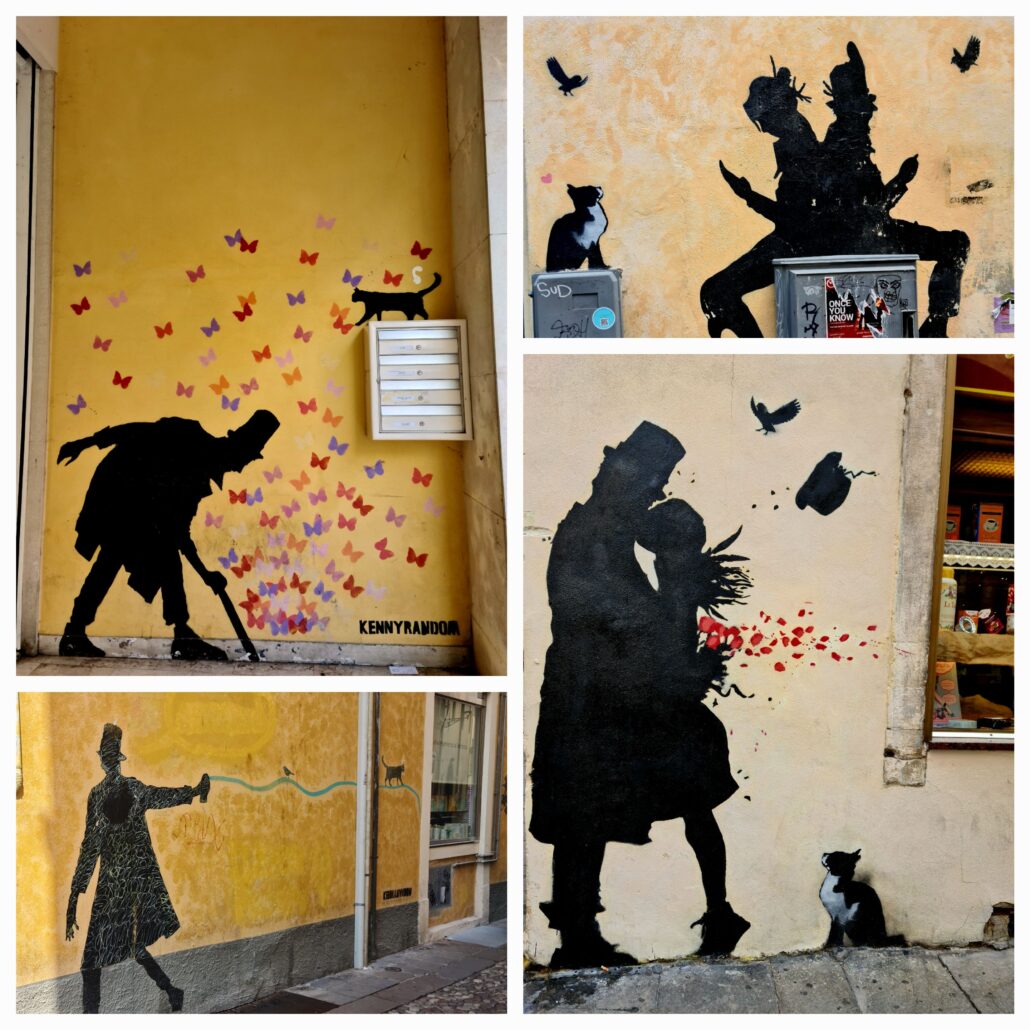
Where to eat
Tian Yi JiAO Padova Angolo del Mondo – excellent Chinese food with a hint of Italian and prosecco on tap. Mainly Asian clientele. On the main road leading from the old town to the train station.
The more traditional Italian style restaurant, Osteria L’Anfora, has an oldie-worldie feel to it. Walls are lined with old photos, posters, and playbills with the odd caricature of the owner, who was pottering around doing this thing. A very local crowd, which is always a good sign. Reviewed in 2018 and while the prices may be a tad higher, the place doesn’t seem to have changed much.
Notes for next time
- Palazzo del Bó and the University – guided tour to see the anatomical theatre and Galilieo pulpit.
- Palazzo della Ragione – it might be open – medieval building with an 80-meter-long hall
- Maybe the botanical gardens – the oldest in the world (1545)
- Casa della Farfalle – the world’s first butterfly and fairy garden using sounds, colours, and plants to bring African, Asian, and Amazonian rainforests to Italy
- The Baptistry next to the Duomo
- San Tomaso Beckett church with its 15 canvases on the ceiling depciting the mysteries of the rosary
Share this:
- Click to share on X (Opens in new window) X
- Click to share on Facebook (Opens in new window) Facebook
- Click to share on Pinterest (Opens in new window) Pinterest
- Click to share on LinkedIn (Opens in new window) LinkedIn
- Click to share on Reddit (Opens in new window) Reddit
- Click to share on WhatsApp (Opens in new window) WhatsApp
- Click to share on Pocket (Opens in new window) Pocket
- Click to share on Telegram (Opens in new window) Telegram
- Click to email a link to a friend (Opens in new window) Email



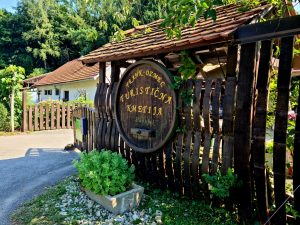



2 responses
Thank you so much for the Giotto’s ……..art ‘A’ level classes come flooding back.
You’re welcome. Hadn’t realised Padua was such a fresco city.